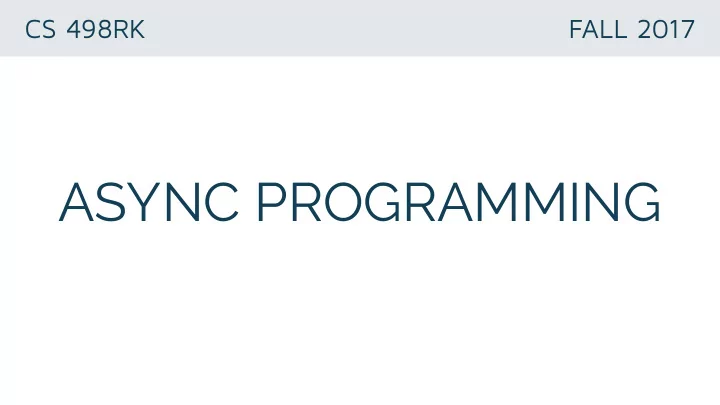

CS 498RK FALL 2017 ASYNC PROGRAMMING
What does this print? function getY() { var y; $http.get(“/gety”, function(jsonData){ // suppose the value of y on the server is 3 y = jsonData.y; }); return y; } var x = 5; var y = getY(); console.log(x + y);
Can’t return values in async world! function getY() { var y; $http.get(“/gety”, function(jsonData){ y = jsonData.y; }); return y; } var x = 5; var y = getY(); console.log(x + y);
Continuation Passing Style
CONTINUATION PASSING STYLE (CPS) function getY(continueWith) { $http.get(“/gety”, function(jsonData) { continueWith(jsonData.y); }); } var x = 5; getY(function(y) { console.log(x + y); });
CALLBACK STYLE PROGRAMMING callbackhell.com
Promises
PROMISES so fu ware abstraction for dealing with “callback hell” move from CPS style getTweetsFor("domenic", function (err, results) { // the rest of your code goes here. }); to one where functions return a value, called a promise var promiseForTweets = getTweetsFor("domenic"); https://gist.github.com/domenic/3889970
CommonJS Promises/A A promise is defined as an object that has a function as the value for the property 'then': then(fulfilledHandler, errorHandler, progressHandler) Adds a fulfilledHandler , errorHandler , and progressHandler to be called for completion of a promise. The fulfilledHandler is called when the promise is fulfilled. The errorHandler is called when a promise fails. The progressHandler is called for progress events. All arguments are optional and non-function values are ignored… wiki.commonjs.org/wiki/Promises/A
CommonJS Promises/A This function should return a new promise that is fulfilled when the given fulfilledHandler or errorHandler callback is finished. This allows promise operations to be chained together. The value returned from the callback handler is the fulfillment value for the returned promise. If the callback throws an error, the returned promise will be moved to failed state. wiki.commonjs.org/wiki/Promises/A
IMPLICATIONS treat promises are first-class object: pass as parameters, aggregate, etc. no more nested callbacks (CPS style) “The point of promises is to give us back functional composition and error bubbling in the async world” https://gist.github.com/domenic/3889970
Promise Chaining getTweetsFor("domenic") // promise-returning async function .then(function (tweets) { var shortUrls = parseTweetsForUrls(tweets); var mostRecentShortUrl = shortUrls[0]; return expandUrlUsingTwitterApi(mostRecentShortUrl); // promise- returning async function }) .then(doHttpRequest) // promise-returning async function .then( function (responseBody) { console.log("Most recent link text:", responseBody); }, function (error) { console.error("Error with the twitterverse:", error); } );
Web Apis
REST vs SOAP resources vs operations REST new-hotness SOAP security, ACID transactions, reliable messaging spf13.com/post/soap-vs-rest
WEB APIs application program interface to a defined request-response message system between clients and servers accessible via standard HTTP methods request URLs that transfer representations (JSON, XML) spf13.com/post/soap-vs-rest
XMLHttpRequest most widely deployed API client in the world a copy in every web browser most sites today are built on top of APIs designed for consumption by XMLHttpRequest
arRESTed Development
SEMANTIC CHALLENGE Learning one API doesn’t help a client learn the next one
NEXT CLASS: DATABASES courses.engr.illinois.edu/cs498rk1/
Recommend
More recommend